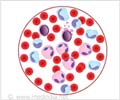Scientists provides the first statistically-based guidelines for determining whether a stem cell transplant is appropriate for older patients with myelodysplastic syndromes (MDS).

The new study was led by an international team of Dana-Farber Cancer Institute.
Using mathematical models to analyze hundreds of MDS cases from around the world, the researchers found reduced intensity transplants of donor stem cells are advisable for patients aged 60-70 who have higher-risk forms of MDS that are likely to turn into leukemia in the near future. For patients with lower-risk MDS, non-transplant treatments are preferable, the model indicates.
The research was reported online today in the Journal of Clinical Oncology.
"Our study helps inform older MDS patients and their doctors whether a stem cell transplant is preferred or whether it makes more sense to pursue other options," says John Koreth, MBBS, DPhil, medical oncologist in the Division of Hematologic Malignancies at Dana-Farber, who is the study's lead author and co-principal investigator (with Joseph Pidala, MD, MS, of the H. Lee Moffitt Cancer & Research Institute, and senior author Corey Cutler, MD, MPH, of the Division of Hematologic Malignancies at Dana-Farber). "Until now, there haven't been statistically-quantified guidelines for making these decisions for older patients, who are most impacted by the disease."
MDS arises in the blood-forming cells of the bone marrow, causing a drop in the number of healthy white and red blood cells and of platelets needed for blood clotting. Depending on which type of cells are in short supply, the result can be fatigue, shortness of breath, easy bruising and bleeding, or infection and fever. An estimated 12,000 people in the United States are diagnosed with MDS each year, and more than 80 percent of whom are over age 60. (Some researchers believe MDS to be widely under-diagnosed, so the number of people affected may be much larger.)
Patients in the first two categories, with lower-risk disease, usually receive treatments such as antibiotics, transfusions, blood cell growth-promoting agents, or other supportive therapies to alleviate their specific symptoms. Patients in the latter two categories, with higher-risk disease, often receive chemotherapy.
"It hasn't been clear for which older patient groups the benefits of transplant outweigh the risks," Koreth says. To find out, researchers collected data on 514 patients, age 60-70, who were newly diagnosed with MDS. For both lower- and higher-risk groups, they built separate mathematical models to compare treatment outcomes in patients who received reduced-intensity donor stem cell transplants with outcomes in patients who received non-transplant therapies. They analyzed not only length of survival but also the quality of life of patients in those groups.
Patients in the lower-risk groups who underwent transplant lived an average of 38 months after treatment, less than the 77 months for those who were treated without transplant. For patients in the higher-risk groups, by contrast, average life expectancy was 36 months for those receiving transplants, better than the 28 months for those receiving non-transplant therapies. Adjusting for patients' quality of life did not change the conclusions regarding the relative merits of the treatments.
"The clear result is that, on balance, reduced-intensity stem cell transplantation offers a survival benefit for patients with higher-risk MDS, but not for those with lower-risk disease," Koreth says. "The findings should offer useful guidance for older patients with MDS on deciding the best course of treatment."
Study co-authors include Waleska Perez, MPH, and Mary Horowitz, MD, CIBMTR Statistical Center; H. Joachim Deeg, MD, and Stephanie Lee, MD, Fred Hutchinson Cancer Research Center; Guillermo Garcia-Manero, MD, M.D. Anderson Cancer Center; Luca Malcovati, MD, and Mario Cazzola, MD, University of Pavia Medical School, Italy; Sophie Park, MD, PhD, Universite Paris V, France; Raphael Itzykson, MD, Lionel Ades, MD, and Pierre Fenaux, MD, Universite Paris 13, France; Martin Jadersten, MD, PhD, and Eva Hellstrom-Lindberg, MD, PhD, Karolinska Institutet, Sweden; C. L. Beach, PharmD, Celgene Corp.; Robert Peter Gale, MD, PhD, Celgene Corp. and Imperial College, London, U.K.; Peter Greenberg, MD, Stanford University School of Medicine; Martin Tallman, MD, Memorial Sloan-Kettering Cancer Center; John DiPersio, MD, PhD, Washington University School of Medicine, St. Louis; Donald Bunjes, MD, of University Hospital Ulm, Germany; and Daniel Weisdorf, MD, University of Minnesota.
Source-Newswise
 MEDINDIA
MEDINDIA



 Email
Email










